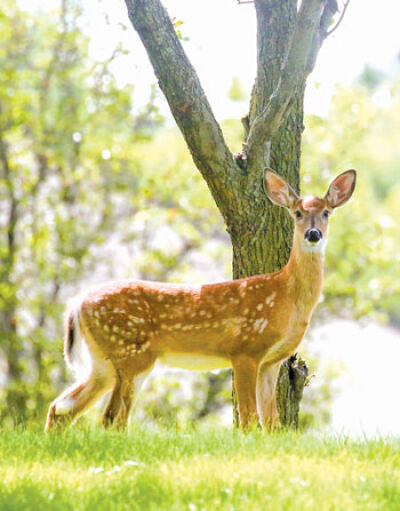
Multiple communities have been involved in trying to address the deer population in the region. West Bloomfield Township Supervisor Steven Kaplan said that the community is split in regard to what to do about the deer population, with some wanting to find a solution to get rid of the deer and others wanting them to be left alone.
File photo by Patricia O’Blenes
METRO DETROIT — According to Farmington Hills Assistant City Manager Joe Valentine, a regional deer survey has been completed by the Southeast Michigan Council of Governments in an effort to come up with a regional solution to address the deer population.
The Oakland County Community Deer Coalition was created in 2021 by a group of leaders in nine Oakland County communities, according to a press release that was previously shared.
The release stated that, in recent years, the deer population has grown steadily throughout Oakland County, which has led to an increase in the number of deer-related auto accidents, damage to landscaping and private property, and greater potential for Lyme disease and other illnesses that can be spread by deer.
The communities in the coalition are Farmington, Farmington Hills, West Bloomfield, Auburn Hills, Beverly Hills, Birmingham, Franklin, Rochester Hills and Southfield.
The coalition partnered with SEMCOG and has also worked with the Michigan Department of Natural Resources to formulate a regional plan.
SEMCOG serves the southeast Michigan region, made up of Oakland, Macomb, Wayne, Livingston, Monroe, St. Clair and Washtenaw counties.
Valentine said that the seven counties were included in the distribution of the survey.
“We partnered with SEMCOG, who did a regional deer survey on our behalf to gain the temperament of the region on how deer are affecting their particular neighborhoods in the seven-county area,” Valentine said. “That data has been provided to us, the coalition, and we are working through that to identify an action plan going forward from that data, which is in conjunction with the process the MDNR has laid out for the coalition to implement some new strategies to deal with deer.”
Valentine said that the data are with SEMCOG.
“The coalition has established a subcommittee to work from that data to identify action items that we can bring forward to the DNR,” he said. “Once we work through that process, we envision the coalition coming back to the various communities in our region and outlining what this action plan looks like. We’re anticipating that to be done sometime this fall. We will be releasing it once we get through our study to talk about what we’ve done, how we got there and what has driven the action items that we will be pursuing as part of this initiative.”
Valentine estimated that the responses to the survey numbered 12,000, which is higher than he expected.
West Bloomfield conducted its own survey in November of last year, and according to Township Supervisor Steven Kaplan, there was an “astounding” response to it, with 1,569 residents taking part.
“We have an interesting dynamic,” Kaplan said. “I would say there’s a split in the community — 50% love the deer and 50% don’t want the deer.”
Kaplan is in favor of launching an education campaign, via local cable television, to deter residents from feeding deer.
Another potential remedy is to have an ordinance enacted that prohibits the feeding of deer in the township. However, from Kaplan’s perspective, there are flaws with that scenario.
“It’s extremely difficult to enforce because we’re not going to hire undercover police officers to hide in the bushes, waiting for people to leave a piece of meat for a deer,” he said. “Do we want people to have to pay fines and have criminal records because they fed the deer? So that’s more of an educational component, but it’s common sense — don’t feed the deer. If fewer people fed the deer, the deer would find other places to romp.”
One of the top complaints from residents about deer is the damage they cause to landscaping.
“Feeding the deer is the No. 1 cause for the proliferation of deer in West Bloomfield, and then the fact is, with development occurring, there’s less room for deer to meander,” Kaplan said. “Might’ve been a forest, might’ve been an area with woodlands, might’ve been an area where people grew plants, (but) now you have more areas filled in with single-family homes and apartments. That means the deer are disrupted. They’re dislodged. So that’s why they’re more likely to be found in somebody’s backyard than a forest area.”
For some, the solution to the deer population problem is simply to reduce the number of them, but one of the suggested ways of doing that isn’t likely to sit well with many residents.
“Do you send in sharpshooters to kill them? Nobody’s in favor of that,” Kaplan said. “(A) cull is where deer are lured to an open area and then they’re shot, they’re extinguished. That would not be a popular move in West Bloomfield. Do we (want to) have our police officers spending time shooting deer, as opposed to deterring crime?”
Valentine also recognizes that seeing deer in their community causes a mixed reaction among residents.
“There’s a host of issues that seem to surface to the top of the concerns that we’re hearing, but on the other token, we have a section of the community that loves seeing the deer and is happy with their presence, so it’s really trying to strategize an approach that manages this issue while addressing both levels of feeling for the deer,” he said.
Gerry Therrien has been a resident of West Bloomfield for more than 20 years, and he said that deer have “been an issue since I’ve been here.”
“I live across the road from a 90-acre nature preserve. Other parts of West Bloomfield are not so inclined, but I’m right next to this nature preserve and that’s where they are,” Therrien said.
Therrien is a proponent of a deer cull.
“My daughter contracted Lyme disease from deer ticks,” he said. “It’s a painful thing, and she’s not over it yet. That was many years ago. Somebody needs to step up and find a means of decreasing the population of deer here.”
Some experts have different opinions of whether that would work to reduce Lyme risk.
“The evidence that reducing deer density will reduce tick density is strong,” states Oxford University Press’ Journal of Integrated Pest Management.
However, a Humane Society information campaign says that killing deer does not necessarily solve the problem.
“Killing deer can make matters worse with respect to human infection. Although adult ticks prefer a large host like deer, they will switch to alternative hosts when their preferred host species isn’t available or the ticks will congregate at higher densities on any remaining deer,” states the site, which notes that the tick is now called the black-legged tick and has hosts other than deer.
Although he understands that it could be challenging, from West Bloomfield resident Jerold Zwar’s perspective, it would be ideal to have the deer shot with a tranquilizer and then taken to a location outside of the township and released.
“They’re going to have to shoot them with a drug, with some kind of medication in it, and haul them away, but (it) takes a lot of money to do that,” Zwar said.
Another potential solution that has been discussed is lacing food with contraceptives so that female deer cannot become impregnated. Later this year, solutions may be more clearly in focus.
“We’re not there yet, in terms of those options,” Valentine said. “That’s what the subcommittee’s going to be discussing as we move forward, so we don’t have any definitive options at this point, other than we’re evaluating all this information and we’ll be formulating those as we go. We’re not looking for a single solution, we’re looking for multiple solutions, because the circumstances are a little different in each community, and having kind of a cafeteria-style plan that we can go to, to really customize the action items for a particular community, makes a lot more sense than saying there’s one solution for everybody. That’s why it’s going to take some time to vet that all out.”
Valentine provided an explanation as to why it is so commonplace to see deer in the area.
“From our area, we have a lot of wetland corridors. We have a lot of green corridors. We have a lot of density, and we have a lot of roads,” he said. “You put all that together, and it creates a combination for high interaction of people and deer.”
If a deer is found dead on private property, according to Kaplan, it is the homeowner’s responsibility to incur the expense.
“If the deer is on the street or right-of-way, then the Road Commission is responsible for removing the dead or injured deer,” Kaplan said. “If the deer is on a safety path, the township safety path — those are on the main roads — then the township is responsible for removing the deer.”
To potentially lessen some of the problems that are being caused by deer, Kaplan offered another idea.
“We can’t tell people what to do, but if they erect what’s called a short fence around their area then it’s less likely for the deer to penetrate that area,” he said.
 Publication select ▼
Publication select ▼






















